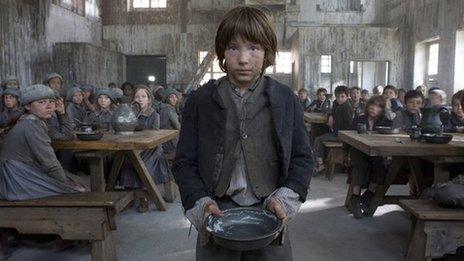A Christmas Carol: How to celebrate like Charles Dickens
- Published
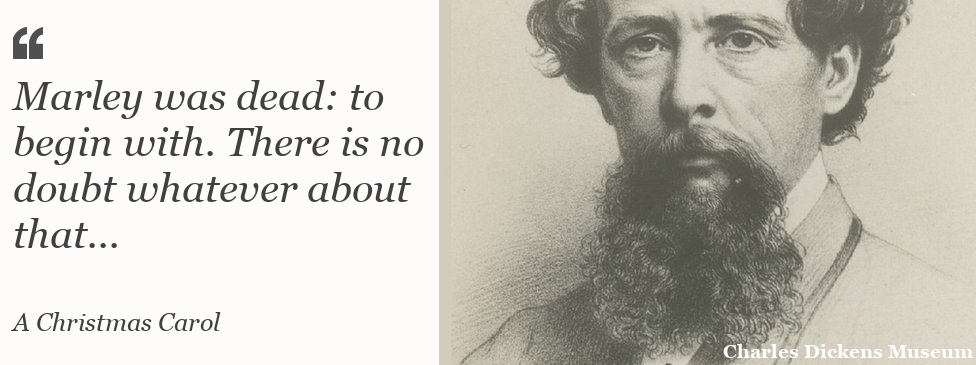
It is 175 years since Charles Dickens introduced the world to his vision of Christmas in A Christmas Carol, and from the outset it proved extremely popular.
Within six days the entire print run of 6,000 copies had sold out. Within six weeks theatre adaptations had hit London's theatres.
The Victorians of the early 1840s clearly did not have a problem with keeping the Christmas spirit going.
And nor did Dickens - although six weeks would probably be pushing it a little too far even for him.
For the famous writer was someone who took the festive period very seriously and his novella encapsulated the things he loved most about the season.
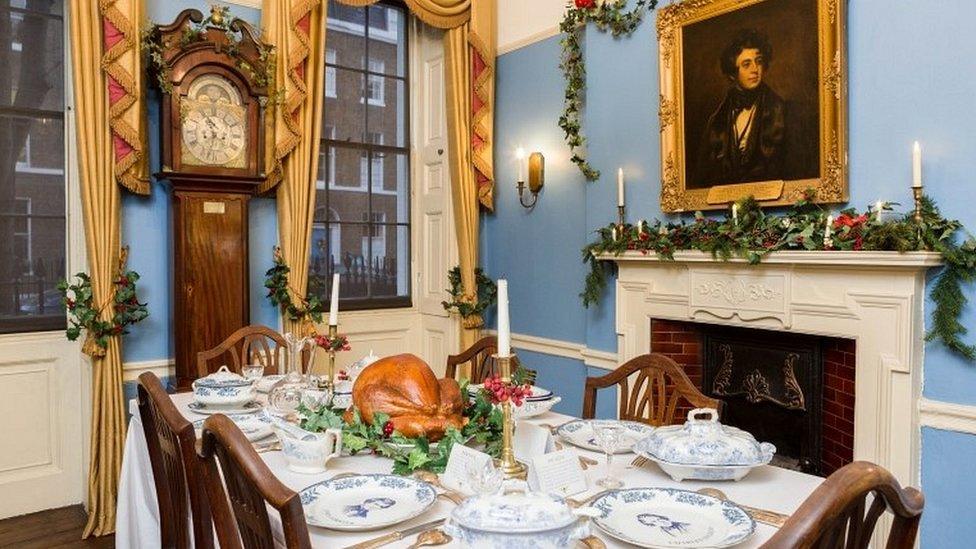
Charles Dickens' home would have been decked out with ivy, holly and mistletoe
"For Dickens, the entire season was an excuse to celebrate and come together," Dr Cindy Sughrue, director of the Charles Dickens Museum, external, explains.
Those like the writer who had the means to celebrate would begin on Christmas Eve and keep the festivities going until the Twelfth Night celebrations of the 6 January.
These parties would be highlighted with large amounts of food and drink, and the jollity of an evening at the Fezziwigs.
"He was obviously the most incredible host. It really meant something to him to have people to come for dinner," Pen Vogler, food historian and author of Dinner with Dickens, said.
Simon Callow, who is starring in an adaptation of the book in London's West End, performs the Cratchit's goose Christmas dinner
Christmas meals were dictated by class at the time the book was published in 1843.
Poor families like the Cratchits would have goose, the rich enjoyed the likes of venison and beef, and the middle classes like Dickens would dig into a turkey.
And like today, turkey leftovers would remain high on the Dickens menu after the big day.
On 2 January 1840 he sent a letter thanking his publishers for their gift of a large bird, saying it had only been finished "at breakfast yesterday... having furnished forth seven grills, one boil, and a cold lunch or two."

Dickens' festive food
As picked by Pen Vogler
Mutton stuffed with oysters - this was one of Dickens' favourite dishes and his wife Catherine included a recipe for it in her cookbook What Shall We Have for Dinner which was published in 1851
Pork - in Pip's family Christmas dinner in Great Expectations, they enjoyed pickled pork (essentially, a large ham served hot). Pork Pie was also a classic, country Christmas treat
Toasted cheese - this was usually served with "watercresses" and was a huge favourite with Dickens for intimate winter meals with family and close friends
Twelfth Cake - before Twelfth Night was squeezed out of the festive calendar, the big Christmas fruit cake was eaten then, not on Christmas day
A big meal for lots of friends would have had about four courses, with a number of dishes in each course.
Accompaniments at any winter meal would have included cauliflower, broccoli, carrots, Brussels sprouts, stewed onions or stewed celery, mashed and brown potatoes, and kalecannon.

Dinner parties held throughout the season would see the likes of mutton stuffed with oysters and steak and turtle being served to guests.
These would be washed down with wine, champagne and port, along with a punch which may horrify some drink connoisseurs.
"His favourite at Christmas was a gin punch which uses milk." This may sound odd but in fact "it tasted like a really, really, buttery chardonnay," according to Dr Sughrue.
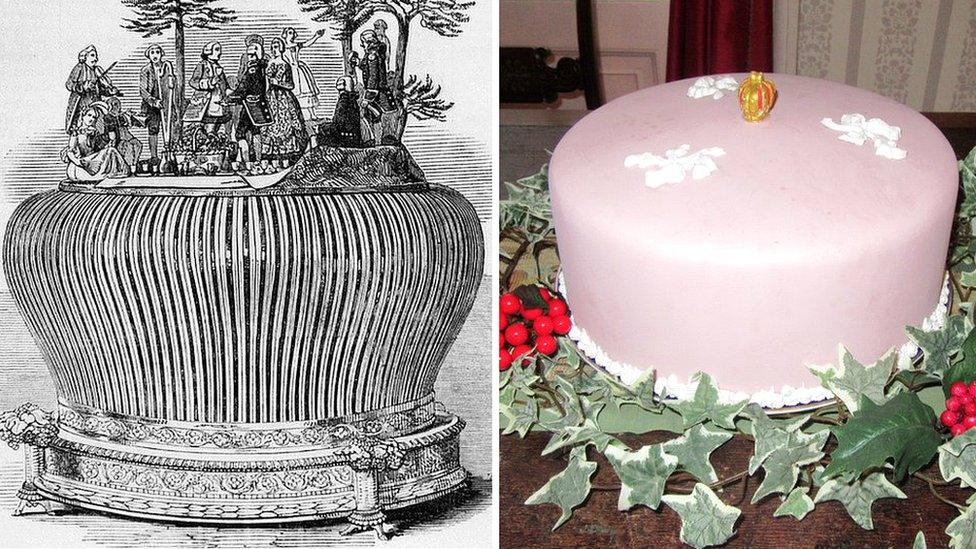
Instead of a Christmas cake, early Victorians had Twelfth Cake on 6 January - Queen Victoria's (left) was rather more impressive than the average family one (right)
With guests suitably stuffed and sozzled, Dickens would move on to entertaining.
Magic shows would play a part with the writer being "the best conjuror I ever saw", according to Jane Carlyle, a guest at one party over Christmas in 1843.
His tricks that night saw him turn handkerchiefs into confectionary, transform a box of bran into a live guinea pig, and his big finale - boiling a plum pudding "in a gentleman's hat".

Dickens' gin punch
Take 6 lemons - peel off the zest, squeeze out all the juice and throw the whole lot into a bowl
Add 250g fine caster sugar
Add 1 litre gin
Mix thoroughly until the sugar dissolves
Slowly add 1 pint milk, which will start to curdle and separate
Refrigerate for at least 24 hours. Strain through a cheesecloth or coffee filter - it may need more than one straining to clear
To serve: Ice (one or two cubes per glass) and freshly grated nutmeg

Dancing then followed as it often would at a party attended by the writer.
His particular favourite was the grand-sounding Sir Roger de Coverley, a country dance involving lines of couples that would have become rather complicated with a few too many glasses of milky gin.
There would also be games like Blind Man's Bluff and Yes Or No, like that played by Scrooge's nephew Fred in the book.
During quieter moments there were ghost stories, a genre Dickens added to with tales other than his most famous festive novella.
One is actually a more violent version of A Christmas Carol where a gravedigger is taught the errors of his non-festive ways by a group of goblins who take him underground and kick him a lot.
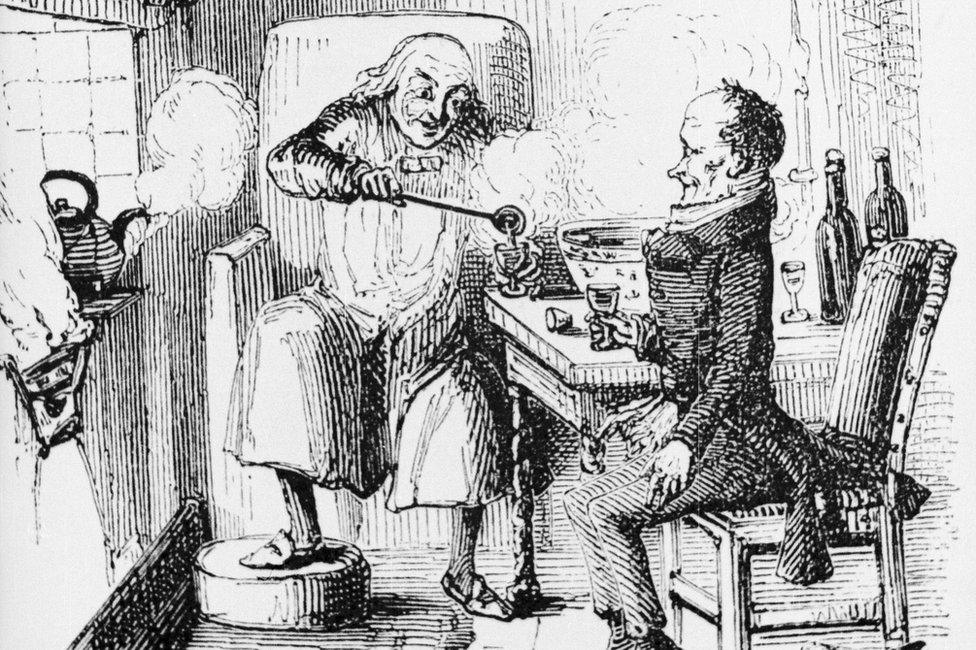
Unlike many adaptations, the book ends with Scrooge and Bob Cratchit enjoying cups of "smoking bishop" punch
While presents did not play such a role as they do today, Dickens made sure his children would be treated at Christmas.
Mamie Dickens, one of his daughters, wrote about how her father took her and her siblings to a toy shop in Holborn on Christmas Eve where they would pick out a gift.
Indeed it was as a child that Dickens learnt his love of the festive season, according to Dickens Museum curator Louisa Price.
His grandparents Elizabeth Ball and William Dickens were servants at Crewe Hall where the owner was particularly fond of Christmas and it is likely they passed this on to the writer's parents.
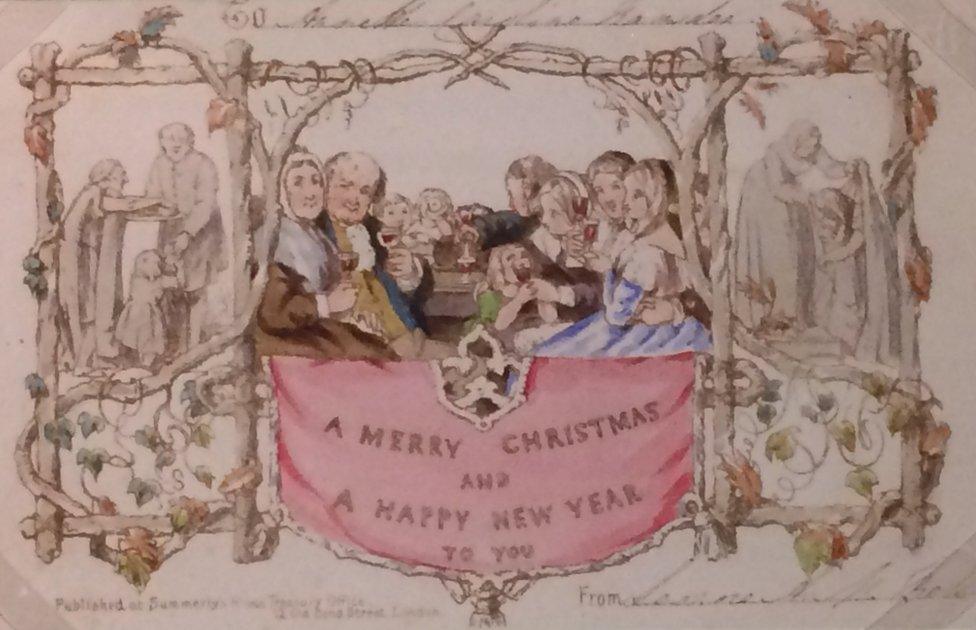
The first commercial Christmas card was also created in 1843
In turn, Dickens passed his excitement about the season to his own descendants.
Jane Monk, the daughter of Dickens' last great-grandson Cedric Dickens who died in 2006, has fond memories of such festivities when she was a child.
"Family Christmas always started early with a Bloody Mary, made as only Dad could make it."
This was followed by "church and everyone doing the veggies before opening of presents, Bucks Fizz and lots of noise," she recalls.
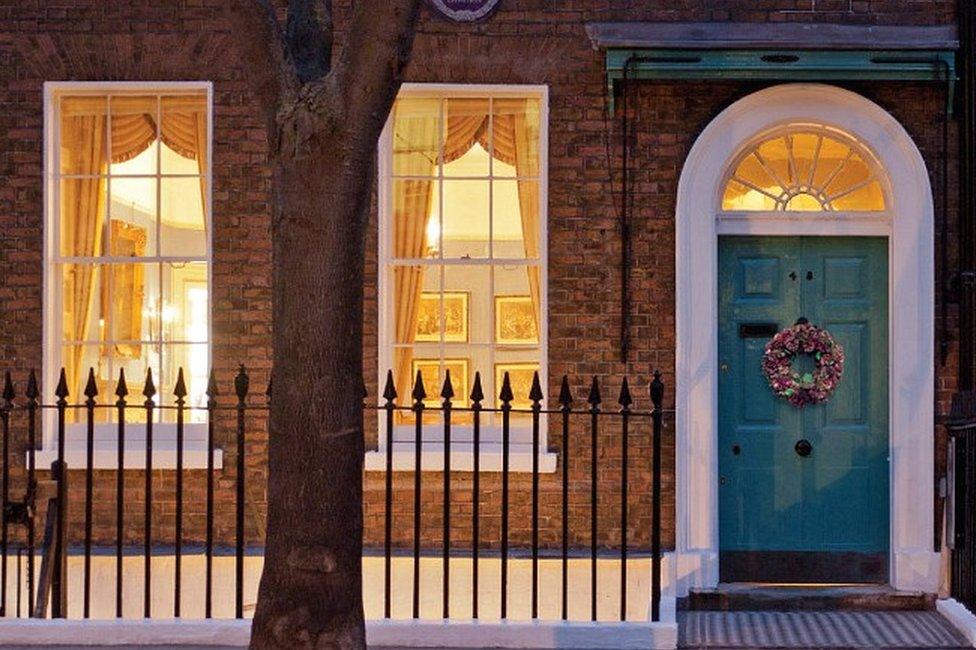
The Charles Dickens Museum is in a house which the writer and his wife moved into in 1837
And the writer's great-great-great-granddaughter Lucinda Hawksley, external continues the family's joy for everything festive.
"Christmas itself is very much about family, friends and dog walking, so I guess that is very much as Dickens himself celebrated it," she said.
"I love having Twelfth Night parties. I always feel slightly in mourning when all the decorations have to come down and the long winter evenings are no longer relieved by sparkling light."
As for the book which anchors her great-great-great-grandfather so heavily to the season, she still considers it a "superb story".
"Its power to affect people is as strong today as it was in the 1840s.
"I am always pleased to hear about adaptations... I hope it continues to evolve with every new generation."
- Published24 December 2017
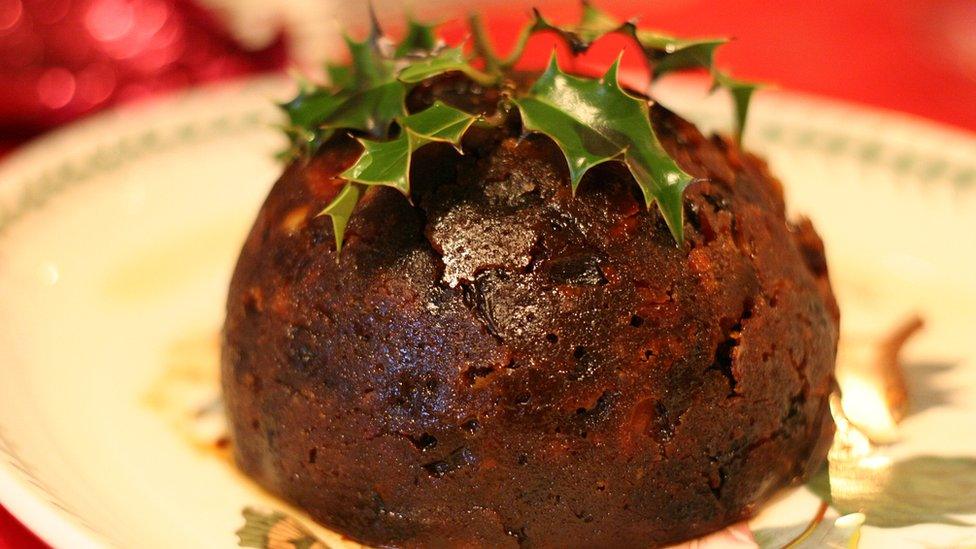
- Published21 December 2017
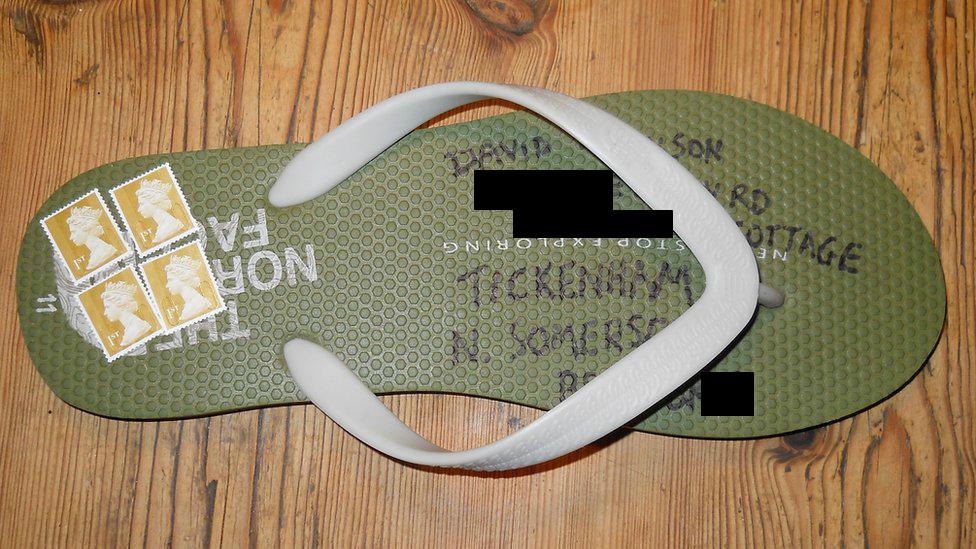
- Published24 December 2016

- Published15 December 2011
